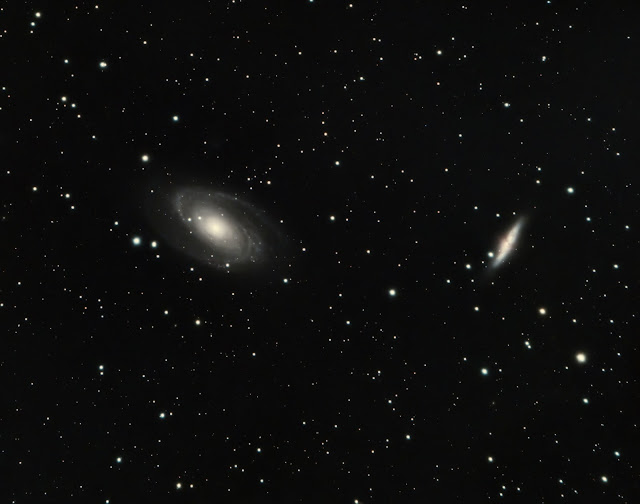Abell 85 or CTB1 is a nearby supernova remnant with an apparent diameter of about a half a degree (about the same size as a Full Moon). Upon early discovery, Abell 85 was thought to be a planetary nebula, so Abell included it in his catalog of planetary nebulae as number 85. Further research showed that Abell 85 is, in fact, a supernova remnant. The deep red color that shows in white in the picture below, comes from light emitted by energized Hydrogen (Ha), but Abell 85 also has an area shining in blue/green light from energized Oxygen (Oiii) atoms.
More about lessons learned and planning but also to share my astrophotography
Friday, November 25, 2022
Very dim supernova remnant, Abell 85 in Oiii
The surrounding Ha light has been shown to be related to CTB1 as well. CTB1 makes for a very challenging object to photograph, as it is quite faint. Without using Ha and OIII filters, the SNR is virtually invisible.
Very dim supernova remnant, Abell 85 in Ha
Abell 85 or CTB1 is a nearby supernova remnant with an apparent diameter of about a half a degree (about the same size as a Full Moon). Upon early discovery, Abell 85 was thought to be a planetary nebula, so Abell included it in his catalog of planetary nebulae as number 85. Further research showed that Abell 85 is, in fact, a supernova remnant. The deep red color that shows in white in the picture below, comes from light emitted by energized Hydrogen (Ha), but Abell 85 also has an area shining in blue/green light from energized Oxygen (OIII) atoms.
The surrounding Ha light has been shown to be related to CTB1 as well.
CTB1 makes for a very challenging object to photograph, as it is quite faint. Without using Ha and OIII filters, the SNR is virtually invisible.
PixInsight Processing:
- Subframe Selector to remove frames based on:
PSF Signal Weight, Elongation, FWHM, # of Stars - Weighted Batch Preprocessing of Lights, Darks, Dark Flats
- WBPP Cosmetic Correction
- Auto Dynamic Crop from WBPP
- Automatic Background Extraction
- EZ processing; EZ Soft Stretch; 30%
- Curves - Multple Slight S-Curves
- LocalHistogramEqualization - Kernel Radius = 25
- LocalHistogramEqualization - Kernel Radius = 75
- LocalHistogramEqualization - Kernel Radius = 125
- Script | Dark Structure Enhance @ 30%
- MultiscaleLinearTransform to sharpen
- StarXTerminator_NL
- NoiseExterminator (Non-Linear)
- Bill Blanshan's Pixel Math Star Reduction V3
Subscribe to:
Posts (Atom)
Galactic Ha Experiment with Bodes and Cigar Galaxies with a One Shot Color camera
I thought it might be a worthy experiment to see how the L-Ultimate filter could add to the Ha detail of galaxies using a OSC Camera. So th...

-
Introduction So, I thought I'd do a test to see results with the ZWO 533MC Pro camera using different gains on the same object. The goal...
-
Sh2-131 This was night 5 of a run of clear nights. VERY unusual in Illinois to say the least. Very happy that I can automate the capturing. ...




PSF Signal Weight, Elongation, FWHM, # of Stars"